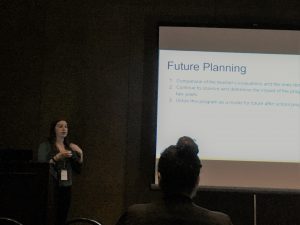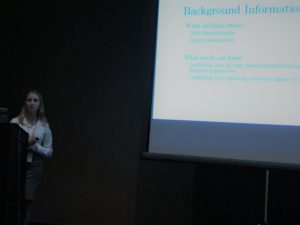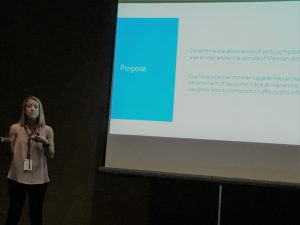Congratulations to Catriona Geddes, Rhiannon Euhus, and Ginny Lee Olivier presented research projects at the 2017 Center for Undergraduate Research Opportunities (CURO) Symposium!
Catriona’s pre sentation, Determining Fidelity of the Physical Activity and Learning (PAL) Program, described how closely the teaching activities mirrored those in the original grant and lesson plans. Using data from random direct observations, she found no difference in the fidelity to teaching strategies or student engagement across math, reading, and physical activity games. She did find that student participation more closely followed the plans in reading than in math (p=0.032). There was room for improvement in all subjects. Process evaluation is important for understanding why we may or may not see desired academic achievement outcomes in students participating in PAL. The next step is to generate an overall implementation score that incorporates these fidelity values with dose delivered, dose received, and participant satisfaction.
sentation, Determining Fidelity of the Physical Activity and Learning (PAL) Program, described how closely the teaching activities mirrored those in the original grant and lesson plans. Using data from random direct observations, she found no difference in the fidelity to teaching strategies or student engagement across math, reading, and physical activity games. She did find that student participation more closely followed the plans in reading than in math (p=0.032). There was room for improvement in all subjects. Process evaluation is important for understanding why we may or may not see desired academic achievement outcomes in students participating in PAL. The next step is to generate an overall implementation score that incorporates these fidelity values with dose delivered, dose received, and participant satisfaction.
Rhiannon examined body image dissatisfaction and pressure to look a certain way among Mexican American students participating in a esthetic and non-aesthetic sports in her project, The Association between Body Image Dissatisfaction and Sports Participation in Mexican-American Youth. She found that 80% of the students reported participating in organized sports. Twenty-one percent of the athletes felt pressure to “look a certain way”, with the majority saying the pressure came from friends, not parents, coaches, or judges. Compared with students who did not play sports, aesthetic sport athletes thought they were smaller than their ideal body image (p=0.0263). BMI percentile, sports participation, physical activity, and sex were significant predictors of body image dissatisfaction (p<0.05 for all associations). These findings provide a better understanding of BID among Mexican-American youth; The results may inform parents and coaches how to identify youth who are at most risk, and aid in the creation of programs that mitigate BID.
esthetic and non-aesthetic sports in her project, The Association between Body Image Dissatisfaction and Sports Participation in Mexican-American Youth. She found that 80% of the students reported participating in organized sports. Twenty-one percent of the athletes felt pressure to “look a certain way”, with the majority saying the pressure came from friends, not parents, coaches, or judges. Compared with students who did not play sports, aesthetic sport athletes thought they were smaller than their ideal body image (p=0.0263). BMI percentile, sports participation, physical activity, and sex were significant predictors of body image dissatisfaction (p<0.05 for all associations). These findings provide a better understanding of BID among Mexican-American youth; The results may inform parents and coaches how to identify youth who are at most risk, and aid in the creation of programs that mitigate BID.
Ginny Lee’ s research, Examining Younger Age at Menarche in Mexican-American Girls, assessed the association between body composition and timing of menarche among Mexican American girls. Girls in this sample attained menarche at a significantly younger age than their mothers by 1.5 years (p=0.000). The relationship between mother’s age at menarche and daughter’s age at menarche was significant after controlling for chronological age and BMI percentile. The relationship between mother’s age at menarche and daughter’s age at menarche did vary by BMI percentile (p=0.008), such that girls who were in a higher BMI percentile had a younger age at menarche relative to their mothers. Similar associations were seen for body fat percentage. As earlier age at menarche has been shown to be associated with greater cardiovascular disease risk, this factor may be considered in prevention efforts.
s research, Examining Younger Age at Menarche in Mexican-American Girls, assessed the association between body composition and timing of menarche among Mexican American girls. Girls in this sample attained menarche at a significantly younger age than their mothers by 1.5 years (p=0.000). The relationship between mother’s age at menarche and daughter’s age at menarche was significant after controlling for chronological age and BMI percentile. The relationship between mother’s age at menarche and daughter’s age at menarche did vary by BMI percentile (p=0.008), such that girls who were in a higher BMI percentile had a younger age at menarche relative to their mothers. Similar associations were seen for body fat percentage. As earlier age at menarche has been shown to be associated with greater cardiovascular disease risk, this factor may be considered in prevention efforts.
All three plan to write up their findings and submit papers for peer-reviewed publication.
